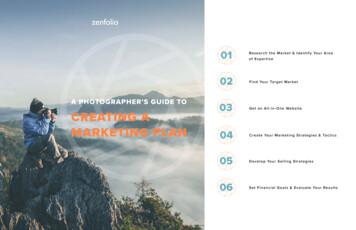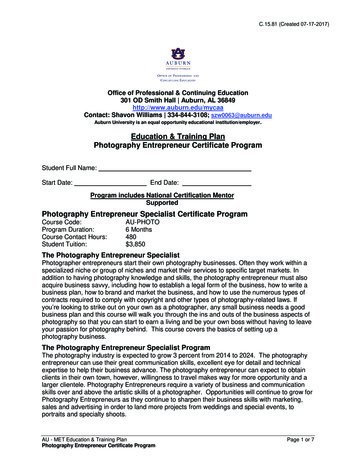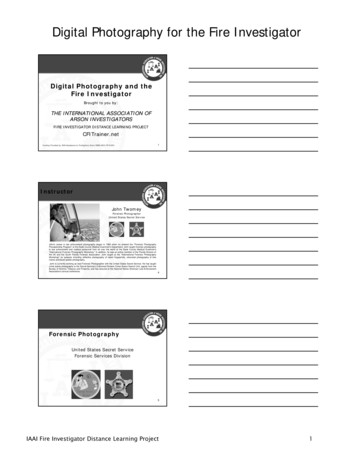PHOTOGRAPHY - WordPress
3/3/2018PHOTOGRAPHYMohamed Nuzrath [MBCS]Coordinator HND IT /Senior Lecturer ITBCAS Kandy CampusFreelance PhotographerFreelance Web/Software DeveloperPHOTOGRAPHYPHOTO - LightGRAPHY – DrawingPHOTOGRAPHY – Drawing with Light1
3/3/2018ABOUT MY /nuzree2
cebook.com/nuzryphotography3
3/3/2018S-lon Water for Life Competition 20164
3/3/2018Contents. Introduction to PhotographyTypes of CamerasTypes of Lenses and other EquipmentsPhotography TechniquesCompositionExposing a PhotographWhat is Shutter speed, Aperture, and ISORule of ThirdsLeading linesMacro / Closup PhotographyShooting PortraitsFlash PhotographyAnd more Types of CamerasFilm CameraPoint and ShootDigital CameraBridge CameraDSLR5
3/3/2018Lenses : kit Lens18-55 AS-S Nikkor F/3.5-5.6 VR Lens6
3/3/20187
3/3/2018Lens : Telephoto/Zoom Lens55-200mm AS-S Nikkor F/4-5.6 VR Lens55-300mm AS-S Nikkor F/4-5.6 VR LensLens: Telephoto/Zoom Lens500mm Nikkor F/4 Super Zoom Lens8
3/3/2018Lens: Prime Lens35mm AF-S NIKKOR F/1.8 G50mm AF NIKKOR F/1.8 D9
3/3/2018Sample ShotsLens: Macro10
3/3/201811
3/3/2018Camera ModesWorking with Command Dial12
3/3/2018CompositionIdeas and TechniquesRule of Thirds13
3/3/2018Rule of Thirds14
3/3/201815
3/3/2018Leading Lines16
3/3/201817
3/3/201818
3/3/201819
3/3/2018Fill the Frame20
3/3/201821
3/3/201822
3/3/2018Leave Space23
3/3/201824
3/3/2018Foreground & Framing25
3/3/201826
3/3/201827
3/3/201828
3/3/201829
3/3/201830
3/3/2018Different PerspectivesHow you shoot a scene determines what kind of story you want to tell and what kind ofmood you want viewers to feel when they look at a photo. The power of perspective isbeyond the consideration of your photography subjects; it is about the angle of yourcamera, your proximity to the subjects and what you include in the frame that plays animportant role in your final image.Shoot from low position straight onSpecially when photographing children it’s a better idea get to their level.31
3/3/2018Shoot from low position straight onSpecially when photographing children it’s a better idea get to their level.Shoot downto get a sense of scale (that the child is small)32
3/3/2018Shoot upwardsto turn tall scenery, like trees or cityscape, into the backdropShoot Wideto show the environment33
3/3/2018Shoot Close upto give an intimate feel or to highlight a particular action or detailInclude Reflectionsto give an additional dimension to an image34
3/3/2018Include Reflectionsto give an additional dimension to an imageInclude Reflectionsto give an additional dimension to an image35
3/3/2018Shoot Behind thingsto make it feel like you’re peeking into a private momentShoot Behind thingsto make it feel like you’re peeking into a private moment36
3/3/2018Before you press the ShutterBefore you press the shutter, take a moment to think abouthow you want your subject to be perceived in the image. Isthere anything you want to highlight? A story you want to tell?You don’t need fancy camera equipment or a bunch ofexpensive lenses to create different perspectives. You justneed creativity and the ability to move around and BAM! Youhave it all.The Basics of ExposureLearning about Exposure – The Exposure TriangleIntroduction to ISO in Digital PhotographyIntroduction to Shutter Speed in Digital PhotographyIntroduction to Aperture in Digital Photography37
3/3/2018The Exposure Triangle38
3/3/201839
3/3/2018The Three Elements areISOthe measure of a digital camera sensor’s sensitivity to lightAperturethe size of the opening in the lens when a picture is takenShutter Speedthe amount of time that the shutter is open40
3/3/2018ISO Settings in a Digital CameraIn traditional (film) photography ISO (or ASA) was the indication of how sensitive afilm was to light. It was measured in numbers (you’ve probably seen them on films –100, 200, 400, 800 etc). The lower the number the lower the sensitivity of the film andthe finer the grain in the shots you’re taking.In Digital Photography ISO measures the sensitivity of the image sensor. The sameprinciples apply as in film photography – the lower the number the less sensitive yourcamera is to light and the finer the grain.Higher ISO settings are generally used in darker situations to get faster shutter speeds.For example an indoor sports event when you want to freeze the action in lower light.However the higher the ISO you choose the noisier shots you will get. I’ll illustrate thisbelow with two enlargements of shots that I just took – the one on the left is taken at100 ISO and the one of the right at 3200 ISOISO Settings in a Digital Camera41
3/3/2018ISO Settings in a Digital Camera100 ISO is generally accepted as ‘normal’ and will give you lovely crisp shots (littlenoise/grain).Most people tend to keep their digital cameras in ‘Auto Mode’ where the cameraselects the appropriate ISO setting depending upon the conditions you’re shooting in(it will try to keep it as low as possible) but most cameras also give you theopportunity to select your own ISO also.When you do override your camera and choose a specific ISO you’ll notice that itimpacts the aperture and shutter speed needed for a well exposed shot. For example– if you bumped your ISO up from 100 to 400 you’ll notice that you can shoot athigher shutter speeds and/or smaller apertures.ISO before choosing ask yourselfLight – Is the subject well lit?Grain – Do I want a grainy shot or one without noise?Tripod – Am I using a tripod?Moving Subject – Is my subject moving or stationary?42
3/3/2018Shutter SpeedWhat is Shutter Speed?As I’ve written elsewhere, defined most basically – shutterspeed is ‘the amount of time that the shutter is open’.In film photography it was the length of time that the film wasexposed to the scene you’re photographing and similarly indigital photography shutter speed is the length of time thatyour image sensor ‘sees’ the scene you’re attempting tocapture.Shutter SpeedShutter speed is measured insecondsor in most cases fractions ofseconds. The bigger thedenominator the faster thespeed (ie 1/1000 is much fasterthan 1/30).If you’re using a slow shutter speed (anything slower than1/60) you will need to either use a tripod or some some type ofimage stabilization (more and more cameras are coming withthis built in).43
3/3/2018Shutter SpeedShutter speeds available to you on your camera will usuallydouble (approximately)with each setting. As a result you’llusually have the options for the following shutter speeds – 1/500,1/250, 1/125, 1/60, 1/30, 1/15, 1/8 etc. This ‘doubling’ is handy tokeep in mind as aperture settings also double the amount of lightthat is let in – as a result increasing shutter speed by one stop anddecreasing aperture by one stop should give you similar exposurelevelsShutter SpeedSome cameras also give you the option for very slow shutterspeeds that are not fractions of seconds but are measured inseconds (for example 1 second, 10 seconds, 30 seconds etc).These are used in very low light situations, when you’re goingafter special effects and/or when you’re trying to capture a lot ofmovement in a shot. Some cameras also give you the option toshoot in ‘B’ (or ‘Bulb’) mode. Bulb mode lets you keep the shutteropen for as long as you hold it down.44
3/3/2018Shutter SpeedWhen considering what shutter speed to use in an image youshould always ask yourself whether anything in your scene ismoving and how you’d like to capture that movement. If there ismovement in your scene you have the choice of either freezingthe movement (so it looks still) or letting the moving objectintentionally blur (giving it a sense of movement).Shutter SpeedTo freeze movement in an image (like in the surfing shotabove) you’ll want to choose a faster shutter speed and tolet the movement blur you’ll want to choose a slowershutter speed. The actual speeds you should choose willvary depending upon the speed of the subject in yourshot and how much you want it to be blurred.45
3/3/2018Shutter SpeedFocal Length and Shutter Speed - another thing to consider when choosingshutter speed is the focal length of the lens you’re using. Longer focal lengthswill accentuate the amount of camera shake you have and so you’ll need tochoose a faster shutter speed (unless you have image stabilization in your lensor camera). The ‘rule’ of thumb to use with focal length in non image stabilizedsituations) is to choose a shutter speed with a denominator that is larger thanthe focal length of the lens. For example if you have a lens that is 50mm 1/60this probably ok but if you have a 200mm lens you’ll probably want to shoot ataround 1/250.Aperture in Digital PhotographyWhat is Aperture?Put most simply – Aperture is ‘the opening in the lens.’When you hit the shutter release button of your camera a holeopens up that allows your cameras image sensor to catch aglimpse of the scene you’re wanting to capture. The aperture thatyou set impacts the size of that hole. The larger the hole the morelight that gets in – the smaller the hole the less light.46
3/3/2018Aperture in Digital PhotographyAperture is measured in ‘f-stops’. You’ll often see them referred tohere at Digital Photography School as f/number – for examplef/2.8, f/4, f/5.6,f/8,f/22 etc. Moving from one f-stop to the nextdoubles or halves the size of the amount of opening in your lens(and the amount of light getting through). Keep in mind that achange in shutter speed from one stop to the next doubles orhalves the amount of light that gets in also – this means if youincrease one and decrease the other you let the same amount oflight in – very handy to keep in mind).Aperture in Digital PhotographyOne thing that causes a lot of new photographers confusion isthat large apertures (where lots of light gets through) are givenf/stop smaller numbers and smaller apertures (where less lightgets through) have larger f-stop numbers. So f/2.8 is in fact amuch larger aperture than f/22. It seems the wrong way aroundwhen you first hear it but you’ll get the hang of it.47
3/3/2018Aperture in Digital PhotographyDepth of Field and ApertureThere are a number of results of changing the aperture of your shots that you’llwant to keep in mind as you consider your setting but the most noticeable onewill be the depth of field that your shot will have.Aperture in Digital PhotographyDepth of Field (DOF) is that amount of your shot that will be in focus. Largedepth of field means that most of your image will be in focus whether it’s closeto your camera or far away (like the picture to the left where both theforeground and background are largely in focus – taken with an aperture off/22).48
3/3/2018Aperture in Digital PhotographySmall (or shallow) depth of field means that only part of the image will be infocus and the rest will be fuzzy (like in the flower ). You’ll see in it that the tip ofthe yellow stems are in focus but even though they are only 1cm or so behindthem that the petals are out of focus. This is a very shallow depth of field andwas taken with an aperture of f/4.5).Aperture in Digital PhotographyAperture has a big impact upon depth of field. Large aperture (remember it’s asmaller number) will decrease depth of field while small aperture (largernumbers) will give you larger depth of field.It can be a little confusing at first but the you can remember it as, smallnumbers mean small DOF and large numbers mean large DOF.49
3/3/2018Aperture in Digital Photographyf/22Aperture in Digital Photographyf/2.850
3/3/2018Aperture in Digital PhotographySome styles of photography require large depths of field (and smallApertures)For example in most landscape photography you’ll see small aperture settings(large numbers) selected by photographers. This ensures that from theforeground to the horizon is relatively in focus.On the other hand in portrait photography it can be very handy to have yoursubject perfectly in focus but to have a nice blurry background in order toensure that your subject is the main focal point and that other elements in theshot are not distracting. In this case you’d choose a large aperture (smallnumber) to ensure a shallow depth of field.Aperture in Digital PhotographyMacro photographers tend to be big users of large apertures to ensure that theelement of their subject that they are focusing in on totally captures theattention of the viewer of their images while the rest of the image iscompletely thrown out of focus51
3/3/2018In future you will be 52
Photography Techniques Composition Exposing a Photograph What is Shutter speed, Aperture, and ISO Rule of Thirds Leading lines Macro / Closup Photography Shooting Portraits Flash Photography And more Types of Cameras Film Camera Digital Camera Point and Shoot Bridge Camera DSLR
Photography 2. Portrait 3. Boudoir Photography 4. Wedding Photography 5. Newborn Photography 6. Landscape Photography 7. Photojournalism 8. Street Photography 9. Food Photography 10. Candid Photography SEARCH WORDS 10 TOP PHOTOGRAPHY WEB
1. Sony World Photography Awards 2. Fine Art Photography Awards 3. National Geographic Photography Competitions 4. Monochrome Photography Awards 5. International Photography Grant 6. Neutral Density Photography Awards 7. Nikon International Small World Photo Contest 8. ZEISS Photography Award 9. Chromatic Color Photography Awards 10. iPhone .
Explain how a professional photography can brand a photography business endeavor and how effective branding can help the photography business Explain the different components of a marketing plan for a photography business Explain common ways that a professional photographer can use social media to advance a photography business .
Photography II Course: Photography II Course Description: Photography II provides the advanced photography student with practical knowledge and highly advanced skills for a comprehensive career in photography. Students will explore advanced lighting and editing techniques and the commercial distribution of photographic works.
Explain how a professional photography can brand a photography business endeavor and how effective branding can help the photography business Explain the different components of a marketing plan for a photography business Explain common ways that a professional photographer can use social media to advance a photography business .
Smartphone Camera o Parts o Exposure o Focus o In Camera Editing o Export/download/share -photography school.com How Using Your Smartphone Camera Can Help Improve Your Photography https://digital-photography-school.com - 8 Ways to Use Your Smartphone for Photography Lynda.com - IOS 10 iPhone Photography and iPad essential training
1.1.3 WordPress.com dan WordPress.org WordPress menyediakan dua alamat yang berbeda, yaitu WordPress.com dan WordPress.org. WordPress.com merupakan situs layanan blog yang menggunakan mesin WordPress, didirikan oleh perusahaan Automattic. Dengan mendaftar pada situs WordPress.com, pengguna tidak perlu melakukan instalasi atau
"International Forensic Photography Workshop." In addition, he was an active member of the Florida Division of the IAI and the South Florida Forensic Association. John taught at the "International Forensic Photography Workshop" on subjects including reflective photography of latent fingerprints, ultraviolet photography of bite























